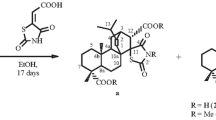Abstract
The condensation of lupininic acid with piperidine in the presence of phosphorus pentoxide forms d-epilupin-inoylpiperidine. The reduction of d-epilupininoylpiperidine with lithium aluminum hydride has given piperidino-d- epilupinane.
Similar content being viewed by others
References
A. S. Sadykov, Kh. A. Aslanov, and T. Tursunbaev, ZhOKh, 30, 3496, 1960.
Kh. A. Aslanov, T. Kasymov, A. S. Sadykov, and A. I. Ishbaev, KhPS [Chemistry of Natural Compounds], 3, no. 6, 412, 1967.
F. Bohlmann, E. Winterfeld and U. Frise. Chem. Ber., 96, 2251, 1963.
Bartholomäus and Schaumann, German patent no. 386936, 1923; 1, 2636, 1924.
Author information
Authors and Affiliations
Additional information
The lupininic acid described in the literature is d-epilupininic acid. So as not to produce confusion, we also call it lupininic acid.
Rights and permissions
About this article
Cite this article
Aslanov, K.A., Kasymov, T.K., Sadykov, A.S. et al. The product of the condensation of lupininic acid with piperidine. Chem Heterocycl Compd 6, 454–456 (1970). https://doi.org/10.1007/BF00478390
Issue Date:
DOI: https://doi.org/10.1007/BF00478390




